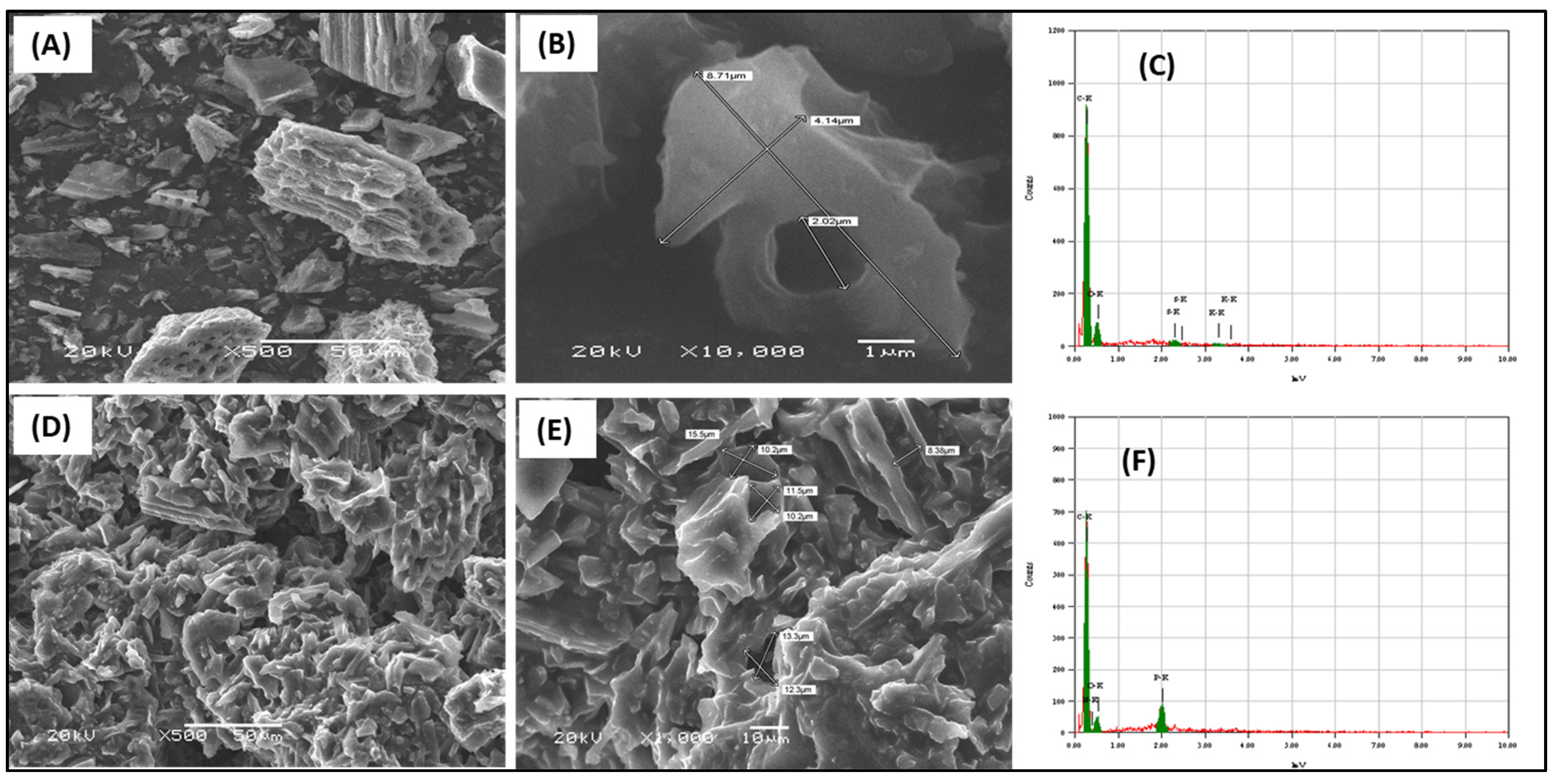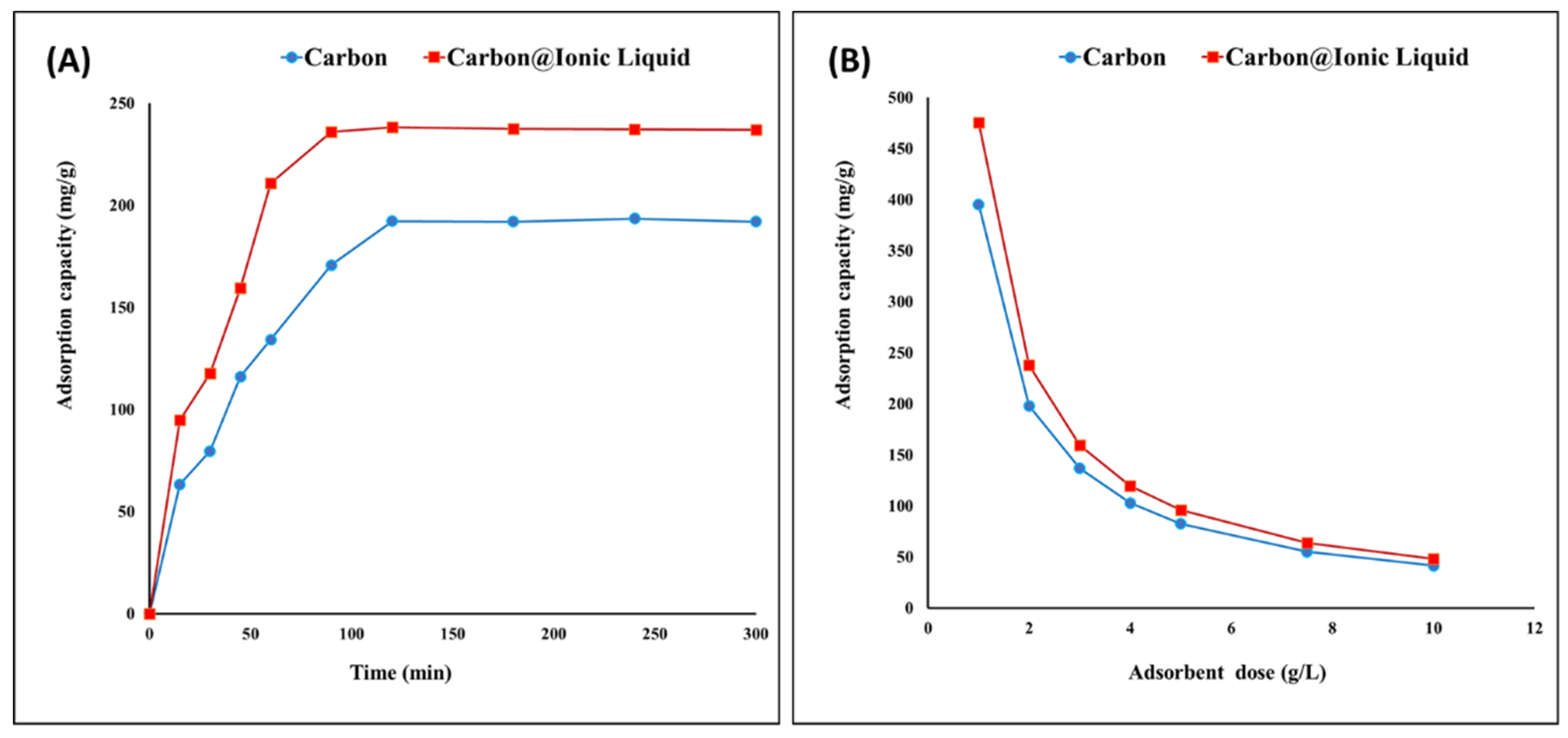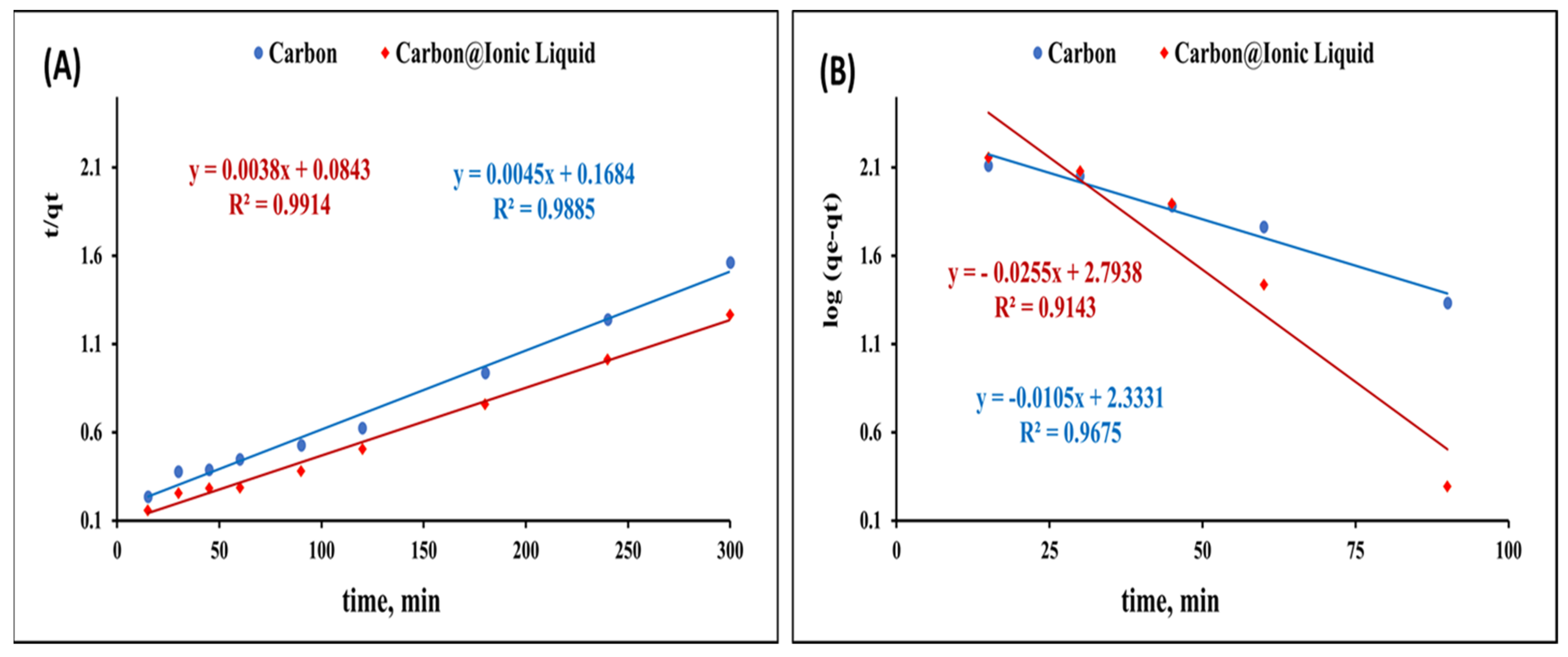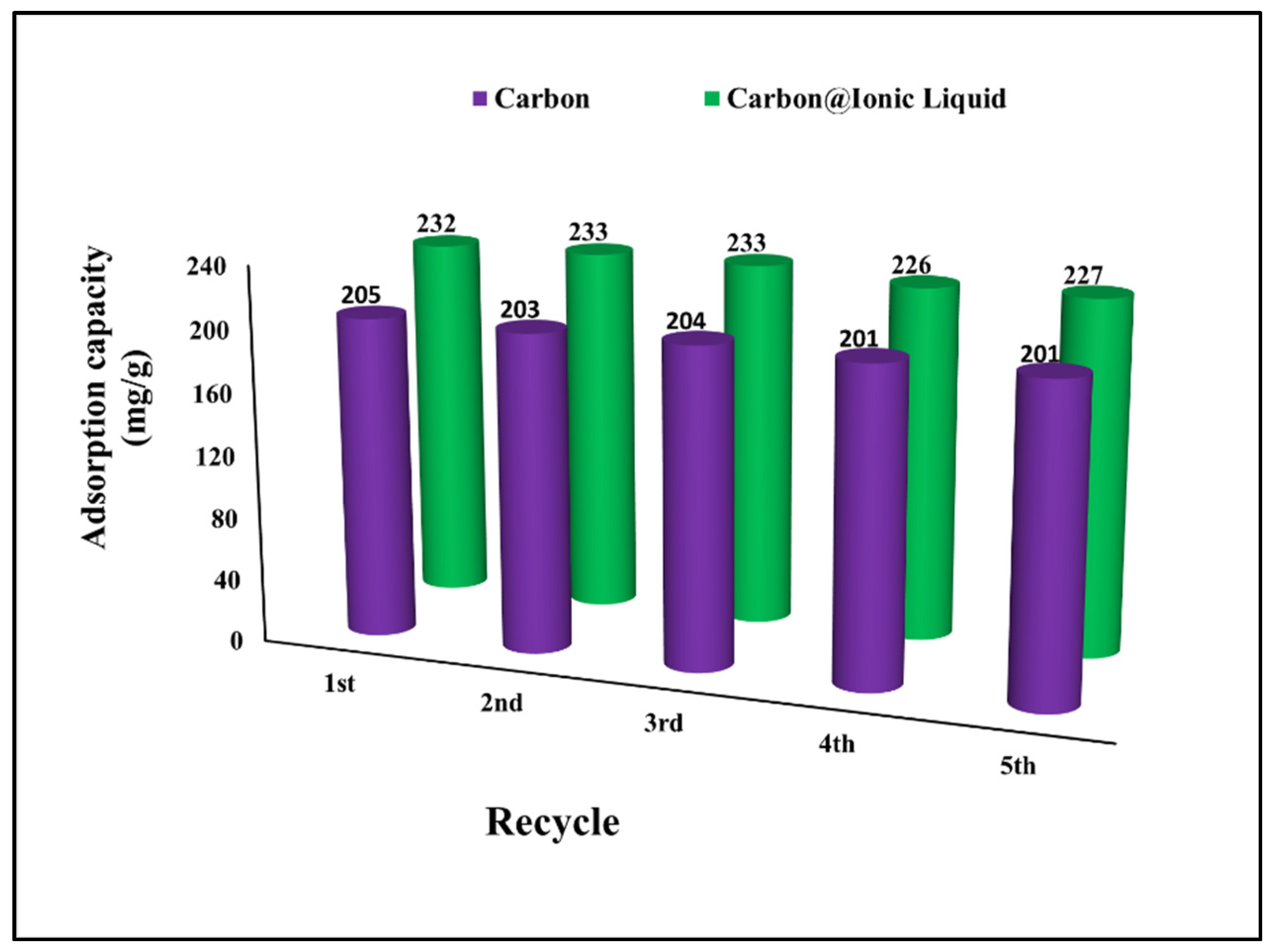Benzothiophene Adsorptive Desulfurization onto trihexYl(tetradecyl)phosphonium Dicyanamide Ionic-Liquid-Modified Renewable Carbon: Kinetic, Equilibrium and UV Spectroscopy Investigations
Abstract
:1. Introduction
2. Results and Discussion
2.1. Structure and Morphological Feature of the Fabricated trihexYl(tetradecyl)phosphonium Dicyanamide-Modified Renewable Carbon
2.2. Adsorption of Benzothiophene Using Carbon and trihexYl(tetradecyl)phosphonium Dicyanamide-Modified Renewable Carbon
2.3. Isotherm Studies
2.3.1. Langmuir Isotherm
2.3.2. Freundlich Isotherm
2.4. Sustainability and Regeneration Approach
3. Materials and Methods
3.1. Preparation of trihexYl(tetradecyl)phosphonium Bis2,4,4-(trimethylpentyl)phosphinate (Cyphos® IL 104)-Modified Activated Carbon
3.2. Application of the Carbon and Carbon@ionic Liquid for the Adsorptive Desulfurization of Boenzothiophene
4. Conclusions
Author Contributions
Funding
Data Availability Statement
Acknowledgments
Conflicts of Interest
Sample Availability
References
- Duan, L.; Gao, X.; Meng, X.; Zhang, H.; Wang, Q.; Qin, Y.; Zhang, X.; Song, L. Adsorption, Co-Adsorption, and Reactions of Sulfur Compounds, Aromatics, Olefins over Ce-Exchanged y Zeolite. J. Phys. Chem. C 2012, 116, 25748–25756. [Google Scholar] [CrossRef]
- Lee, K.X.; Crowl, T.B.; Sokol, H.J.; Morales-Acosta, M.D.; Valla, J.A. Understanding the Role of Rare Earths in Zeolite y on the Removal of Sulfur from Hydrocarbon Fuels. J. Phys. Chem. C 2021, 125, 9107–9118. [Google Scholar] [CrossRef]
- Wagle, D.V.; Zhao, H.; Deakyne, C.A.; Baker, G.A. Quantum Chemical Evaluation of Deep Eutectic Solvents for the Extractive Desulfurization of Fuel. ACS Sustain. Chem. Eng. 2018, 6, 7525–7531. [Google Scholar] [CrossRef]
- Chang, H.; Yi, H.; Zhang, J. Preparation of a NiO-Bi2WO6 Catalyst and Its Photocatalytic Oxidative Desulfurization Performance. Colloid Interface Sci. Commun. 2021, 41, 100381. [Google Scholar] [CrossRef]
- Zhao, R.; Wang, J.; Zhang, D.; Sun, Y.; Han, B.; Tang, N.; Zhao, J.; Li, K. Deep Catalytic Oxidative Desulfurization of Model Fuel Based on Modified Iron Porphyrins in Ionic Liquids: Anionic Ligand Effect. ACS Sustain. Chem. Eng. 2017, 5, 2050–2055. [Google Scholar] [CrossRef]
- Kulkarni, P.S.; Afonso, C.A.M. Deep Desulfurization of Diesel Fuel Using Ionic Liquids: Current Status and Future Challenges. Green Chem. 2010, 12, 1139–1149. [Google Scholar] [CrossRef]
- Paduszyński, K.; Królikowski, M.; Zawadzki, M.; Orzeł, P. Computer-Aided Molecular Design of New Task-Specific Ionic Liquids for Extractive Desulfurization of Gasoline. ACS Sustain. Chem. Eng. 2017, 5, 9032–9042. [Google Scholar] [CrossRef]
- Abro, R.; Abdeltawab, A.A.; Al-Deyab, S.S.; Yu, G.; Qazi, A.B.; Gao, S.; Chen, X. A Review of Extractive Desulfurization of Fuel Oils Using Ionic Liquids. RSC Adv. 2014, 4, 35302–35317. [Google Scholar] [CrossRef]
- Shamsaee, B.H.; Mehri, F.; Rowshanzamir, S.; Ghamati, M.; Behrouzifar, A. Desulfurization of Benzothiophene from Model Diesel Fuel Using Experimental (Dynamic Electroreduction) and Theoretical (DFT) Approaches. Sep. Purif. Technol. 2019, 212, 505–514. [Google Scholar] [CrossRef]
- Lee, K.X.; Valla, J.A. Adsorptive Desulfurization of Liquid Hydrocarbons Using Zeolite-Based Sorbents: A Comprehensive Review. React. Chem. Eng. 2019, 4, 1357–1386. [Google Scholar] [CrossRef]
- Ahmed, I.; Jhung, S.H. Adsorptive Desulfurization and Denitrogenation Using Metal-Organic Frameworks. J. Hazard. Mater. 2016, 301, 259–276. [Google Scholar] [CrossRef]
- Velu, S.; Song, C.; Engelhard, M.H.; Chin, Y.H. Adsorptive Removal of Organic Sulfur Compounds from Jet Fuel over K-Exchanged NiY Zeolites Prepared by Impregnation and Ion Exchange. Ind. Eng. Chem. Res. 2005, 44, 5740–5749. [Google Scholar] [CrossRef]
- Sinhmar, P.S.; Gogate, P.R. Ultra-Deep Desulfurization of Crude Sulfated Turpentine Using Oxidation, Adsorption and Novel Combination Approach. Environ. Technol. Innov. 2020, 18, 100682. [Google Scholar] [CrossRef]
- Crandall, B.S.; Zhang, J.; Stavila, V.; Allendorf, M.D.; Li, Z. Desulfurization of Liquid Hydrocarbon Fuels with Microporous and Mesoporous Materials: Metal-Organic Frameworks, Zeolites, and Mesoporous Silicas. Ind. Eng. Chem. Res. 2019, 58, 19322–19352. [Google Scholar] [CrossRef]
- Saleh, T.A.; Sulaiman, K.O.; AL-Hammadi, S.A.; Dafalla, H.; Danmaliki, G.I. Adsorptive Desulfurization of Thiophene, Benzothiophene and Dibenzothiophene over Activated Carbon Manganese Oxide Nanocomposite: With Column System Evaluation. J. Clean. Prod. 2017, 154, 401–412. [Google Scholar] [CrossRef]
- Choi, A.E.S.; Roces, S.; Dugos, N.; Wan, M.W. Adsorption of Benzothiophene Sulfone over Clay Mineral Adsorbents in the Frame of Oxidative Desulfurization. Fuel 2017, 205, 153–160. [Google Scholar] [CrossRef]
- Amiri, O.; Beshkar, F.; Ahmed, S.S.; Rafiei-Miandashti, A.; Mahmood, P.H.; Dezaye, A.A. Novel Flower-like (Bi(Bi2S3)9I3)2/3 Nanostructure as Efficient Photocatalyst for Photocatalytic Desulfurization of Benzothiophene under Visible Light Irradiation. Adv. Powder Technol. 2021, 32, 1088–1098. [Google Scholar] [CrossRef]
- Zhang, P.; Xu, Y.; Guo, K.; Yin, Y.; Wang, J.; Zeng, Y. Hierarchical-Pore UiO-66 Modified with Ag+ for π-Complexation Adsorption Desulfurization. J. Hazard. Mater. 2021, 418, 126247. [Google Scholar] [CrossRef]
- Ferella, F.; Biancalana, L.; Marchetti, F.; Crucianelli, M. Oxidative Desulfurization of Benzothiophene Derivatives with Cis-Dioxomolybdenum(VI) Catalyst Precursors, under Extractive Conditions. Catal. Today 2020, 357, 646–654. [Google Scholar] [CrossRef]
- Fujiki, J.; Yogo, K.; Furuya, E. Role of Silanol Groups on Silica Gel on Adsorption of Benzothiophene and Naphthalene. Fuel 2018, 215, 463–467. [Google Scholar] [CrossRef]
- Wang, L.; Ma, Y.; Xie, D.; Zhang, M.; Zuo, N.; Mominou, N.; Jing, C. Ultra-Deep Desulfurization of Model Diesel Fuel over Pr/Ce–N–TiO2 Assisted by Visible Light. Microporous Mesoporous Mater. 2021, 323, 111258. [Google Scholar] [CrossRef]
- Zu, Y.; Hui, Y.; Qin, Y.; Zhang, L.; Liu, H.; Zhang, X.; Guo, Z.; Song, L.; Gao, X. Facile Fabrication of Effective Cerium(III) Hydroxylated Species as Adsorption Active Sites in CeY Zeolite Adsorbents towards Ultra-Deep Desulfurization. Chem. Eng. J. 2019, 375, 122014. [Google Scholar] [CrossRef]
- Kan, E.; Choi, Y.K.; Srinivasan, R. Facile and Economical Functionalized Hay Biochar with Dairy Effluent for Adsorption of Tetracycline. ACS Omega 2020, 5, 16521–16529. [Google Scholar] [CrossRef]
- Anisuzzaman, S.M.; Joseph, C.G.; Daud, W.M.A.B.W.; Krishnaiah, D.; Yee, H.S. Preparation and Characterization of Activated Carbon from Typha Orientalis Leaves. Int. J. Ind. Chem. 2015, 6, 9–21. [Google Scholar] [CrossRef] [Green Version]
- Wang, Q.; Li, J.S.; Poon, C.S. Recycling of Incinerated Sewage Sludge Ash as an Adsorbent for Heavy Metals Removal from Aqueous Solutions. J. Environ. Manag. 2019, 247, 509–517. [Google Scholar] [CrossRef]
- Syafiuddin, A.; Fulazzaky, M.A. Decolorization Kinetics and Mass Transfer Mechanisms of Remazol Brilliant Blue R Dye Mediated by Different Fungi. Biotechnol. Rep. 2021, 29, e00573. [Google Scholar] [CrossRef]
- Abdel-Fattah, T.M.; Mahmoud, M.E.; Ahmed, S.B.; Huff, M.D.; Lee, J.W.; Kumar, S. Biochar from Woody Biomass for Removing Metal Contaminants and Carbon Sequestration. J. Ind. Eng. Chem. 2015, 22, 103–109. [Google Scholar] [CrossRef]
- Liu, L.; Guo, X.; Wang, S.; Li, L.; Zeng, Y.; Liu, G. Effects of Wood Vinegar on Properties and Mechanism of Heavy Metal Competitive Adsorption on Secondary Fermentation Based Composts. Ecotoxicol. Environ. Saf. 2018, 150, 270–279. [Google Scholar] [CrossRef]
- Wang, J.; Chen, C. Biosorption of Heavy Metals by Saccharomyces Cerevisiae: A Review. Biotechnol. Adv. 2006, 24, 427–451. [Google Scholar] [CrossRef]
- Timko, M.T.; Wang, J.A.; Burgess, J.; Kracke, P.; Gonzalez, L.; Jaye, C.; Fischer, D.A. Roles of Surface Chemistry and Structural Defects of Activated Carbons in the Oxidative Desulfurization of Benzothiophenes. Fuel 2016, 163, 223–231. [Google Scholar] [CrossRef]
- Khan, N.A.; Hasan, Z.; Min, K.S.; Paek, S.M.; Jhung, S.H. Facile Introduction of Cu+ on Activated Carbon at Ambient Conditions and Adsorption of Benzothiophene over Cu+/Activated Carbon. Fuel Process. Technol. 2013, 116, 265–270. [Google Scholar] [CrossRef]
- Reyes-Garcés, N.; Gionfriddo, E.; Gómez-Ríos, G.A.; Alam, M.N.; Boyacl, E.; Bojko, B.; Singh, V.; Grandy, J.; Pawliszyn, J. Advances in Solid Phase Microextraction and Perspective on Future Directions. Anal. Chem. 2018, 90, 302–360. [Google Scholar] [CrossRef] [PubMed]
- Smith, E.L.; Abbott, A.P.; Ryder, K.S. Deep Eutectic Solvents (DESs) and Their Applications. Chem. Rev. 2014, 114, 11060–11082. [Google Scholar] [CrossRef] [PubMed] [Green Version]
- Zhao, H.; Baker, G.A.; Wagle, D.V.; Ravula, S.; Zhang, Q. Tuning Task-Specific Ionic Liquids for the Extractive Desulfurization of Liquid Fuel. ACS Sustain. Chem. Eng. 2016, 4, 4771–4780. [Google Scholar] [CrossRef]
- Ibrahim, J.J.; Gao, S.; Abdeltawab, A.A.; Al-Deyab, S.S.; Yu, L.; Yu, G.; Chen, X.; Yong, X. Extractive Desulfurization of Fuel Oils with Dicyano(Nitroso)Methanide-Based Ionic Liquids. Sep. Sci. Technol. 2015, 50, 1166–1174. [Google Scholar] [CrossRef]
- Osman, A.; Farrell, C.; Al-Muhtaseb, H.; Harrison, J.; Rooney, D.W. The Production and Application of Carbon Nanomaterials from High Alkali Silicate Herbaceous Biomass. Sci. Rep. 2020, 10, 2563. [Google Scholar] [CrossRef] [Green Version]
- Fatima, S.S.; Borhan, A.; Ayoub, M.; Ghani, N.A. CO2 Adsorption Performance on Surface-Functionalized Activated Carbon Impregnated with Pyrrolidinium-Based Ionic Liquid. Processes 2022, 10, 2372. [Google Scholar] [CrossRef]
- Yusuf, N.Y.M.; Masdar, M.S.; Isahak, W.N.R.W.; Nordin, D.; Husaini, T.; Majlan, E.H.; Wu, S.Y.; Rejab, S.A.M.; Lye, C.C. Impregnated Carbon–Ionic Liquid as Innovative Adsorbent for H2/CO2 Separation from Biohydrogen. Int. J. Hydrogen Energy 2019, 44, 3414–3424. [Google Scholar] [CrossRef]
- Zhang, H.; Li, X.; He, G.; Zhan, J.; Liu, D. Preparation of Magnetic Composite Hollow Microsphere and Its Adsorption Capacity for Basic Dyes. Ind. Eng. Chem. Res. 2013, 52, 16902–16910. [Google Scholar] [CrossRef]
- Momina; Shahadat, M.; Isamil, S. Regeneration Performance of Clay-Based Adsorbents for the Removal of Industrial Dyes: A Review. RSC Adv. 2018, 8, 24571–24587. [Google Scholar] [CrossRef]
- Wang, Y.; Liu, W.; Zhang, J.; Shan, Q. Preparation of Co-Schiff Base Complex and Its Adsorption Desulfurization. Fuel 2022, 324, 124696. [Google Scholar] [CrossRef]
- Qiu, J.; Wang, G.; Bao, Y.; Zeng, D.; Chen, Y. Effect of Oxidative Modification of Coal Tar Pitch-Based Mesoporous Activated Carbon on the Adsorption of Benzothiophene and Dibenzothiophene. Fuel Process. Technol. 2015, 129, 85–90. [Google Scholar] [CrossRef]
- Qiu, S.; Du, J.; Xiao, Y.; Zhao, Q.; He, G. Hierarchical Porous HKUST-1 Fabricated by Microwave-Assisted Synthesis with CTAB for Enhanced Adsorptive Removal of Benzothiophene from Fuel. Sep. Purif. Technol. 2021, 271, 118868. [Google Scholar] [CrossRef]
- Habila, M.A.; ALOthman, Z.A.; Al-Tamrah, S.A.; Ghafar, A.A.; Soylak, M. Activated Carbon from Waste as an Efficient Adsorbent for Malathion for Detection and Removal Purposes. J. Ind. Eng. Chem. 2015, 32, 336–344. [Google Scholar] [CrossRef]
- Habila, M.; AlOthman, Z.; Ghfar, A.; Al-Zaben, M.; Alothman, A.; Abdeltawab, A.; El-Marghany, A.; Sheikh, M. Phosphonium-Based Ionic Liquid Modified Activated Carbon from Mixed Recyclable Waste for Mercury(II) Uptake. Molecules 2019, 24, 570. [Google Scholar] [CrossRef] [PubMed] [Green Version]
- Liu, W.; Liu, X.; Yang, Y.; Zhang, Y.; Xu, B. Selective Removal of Benzothiophene and Dibenzothiophene from Gasoline Using Double-Template Molecularly Imprinted Polymers on the Surface of Carbon Microspheres. Fuel 2014, 117, 184–190. [Google Scholar] [CrossRef]







| Pseudo-First Order | Pseudo-Second Order | ||||||
|---|---|---|---|---|---|---|---|
| qe,exp (mg/g) | K1 (min−1) | qe,cal (mg/g) | R2 | K2 (g/mg·min) | qe,cal (mg/g) | R2 | |
| Carbon | 192 | 0.024 | 215 | 96 | 1.2 × 10−4 | 222.2 | 98 |
| Carbon@ionic liquid | 238 | 0.058 | 622 | 91 | 1.7 × 10−4 | 263.1 | 99 |
| Langmuir Constants | Freundlich Constants | |||||
|---|---|---|---|---|---|---|
| KL | Qmax | R2 | KF | n | R2 | |
| Carbon | 1.55 | 526 | 73 | 1.29 | 1.39 | 89 |
| Carbon@ionic liquid | 2.95 | 294 | 69 | 6.08 | 1.65 | 95 |
| Adsorbent | Adsorption Capacity (mg/g) | References |
|---|---|---|
| HKUST-1 | 14.4 | [43] |
| Activated carbon modified with manganese oxide | 5.7 | [15] |
| Coal-tar-derived carbon | 32.8 | [42] |
| Activated carbon | 192 | This work |
| trihexYl(tetradecyl)phosphonium dicyanamide-modified renewable carbon | 238 | This work |
Disclaimer/Publisher’s Note: The statements, opinions and data contained in all publications are solely those of the individual author(s) and contributor(s) and not of MDPI and/or the editor(s). MDPI and/or the editor(s) disclaim responsibility for any injury to people or property resulting from any ideas, methods, instructions or products referred to in the content. |
© 2022 by the authors. Licensee MDPI, Basel, Switzerland. This article is an open access article distributed under the terms and conditions of the Creative Commons Attribution (CC BY) license (https://creativecommons.org/licenses/by/4.0/).
Share and Cite
Habila, M.A.; ALOthman, Z.A.; ALOthman, M.R.; Hassouna, M.S.E.-D. Benzothiophene Adsorptive Desulfurization onto trihexYl(tetradecyl)phosphonium Dicyanamide Ionic-Liquid-Modified Renewable Carbon: Kinetic, Equilibrium and UV Spectroscopy Investigations. Molecules 2023, 28, 298. https://doi.org/10.3390/molecules28010298
Habila MA, ALOthman ZA, ALOthman MR, Hassouna MSE-D. Benzothiophene Adsorptive Desulfurization onto trihexYl(tetradecyl)phosphonium Dicyanamide Ionic-Liquid-Modified Renewable Carbon: Kinetic, Equilibrium and UV Spectroscopy Investigations. Molecules. 2023; 28(1):298. https://doi.org/10.3390/molecules28010298
Chicago/Turabian StyleHabila, Mohamed A., Zied A. ALOthman, Monerah R. ALOthman, and Mohammed Salah El-Din Hassouna. 2023. "Benzothiophene Adsorptive Desulfurization onto trihexYl(tetradecyl)phosphonium Dicyanamide Ionic-Liquid-Modified Renewable Carbon: Kinetic, Equilibrium and UV Spectroscopy Investigations" Molecules 28, no. 1: 298. https://doi.org/10.3390/molecules28010298
APA StyleHabila, M. A., ALOthman, Z. A., ALOthman, M. R., & Hassouna, M. S. E.-D. (2023). Benzothiophene Adsorptive Desulfurization onto trihexYl(tetradecyl)phosphonium Dicyanamide Ionic-Liquid-Modified Renewable Carbon: Kinetic, Equilibrium and UV Spectroscopy Investigations. Molecules, 28(1), 298. https://doi.org/10.3390/molecules28010298








